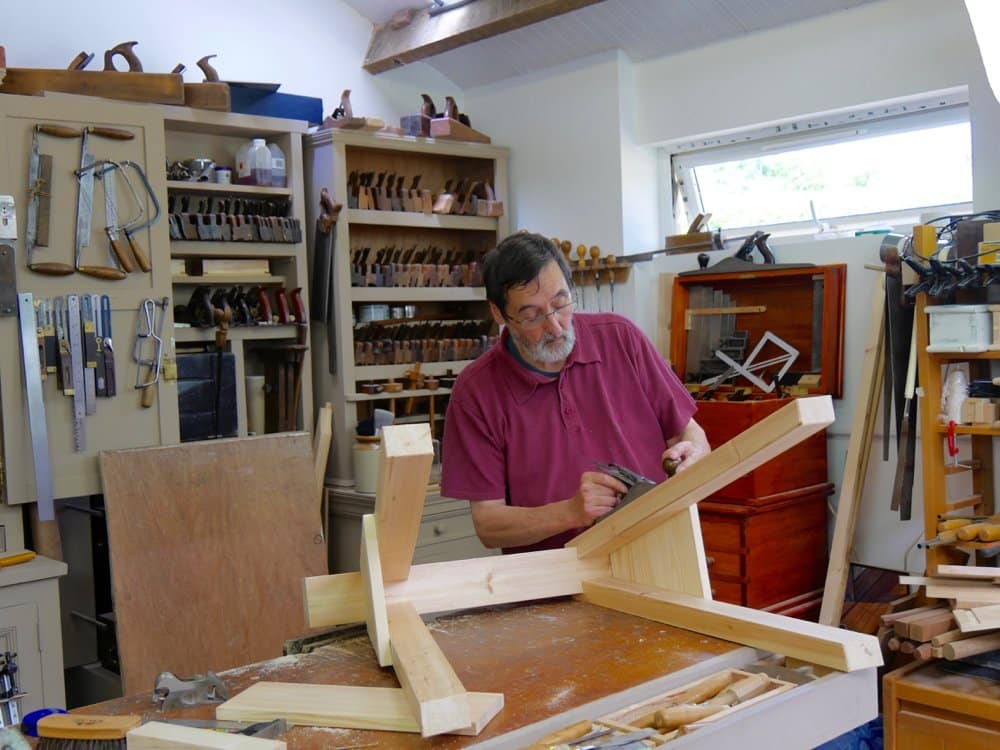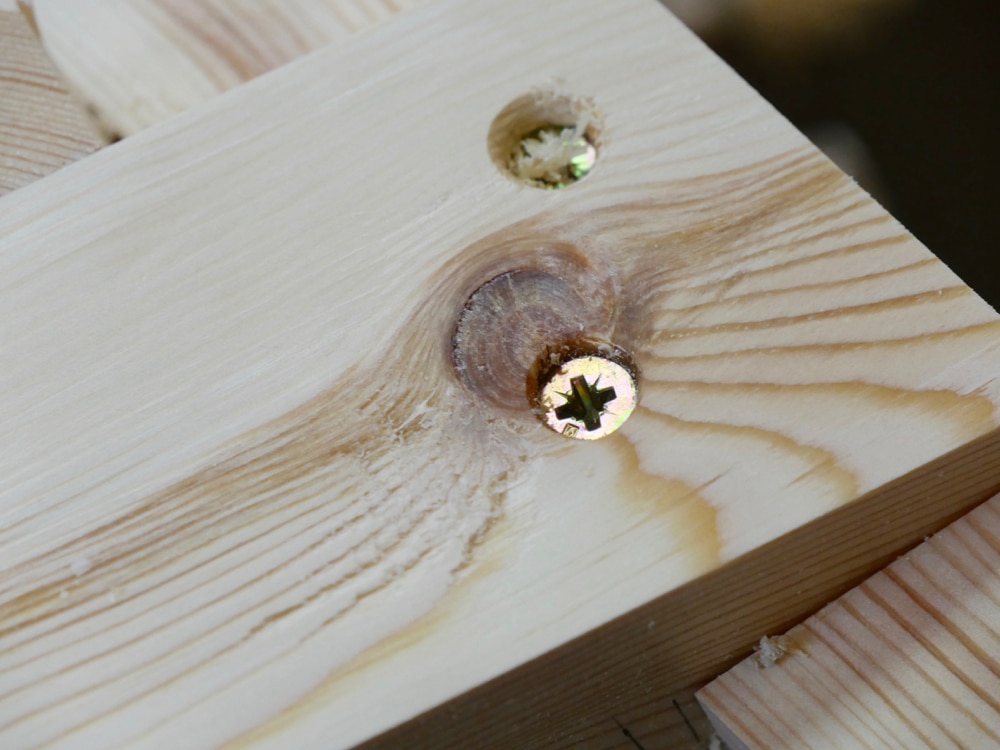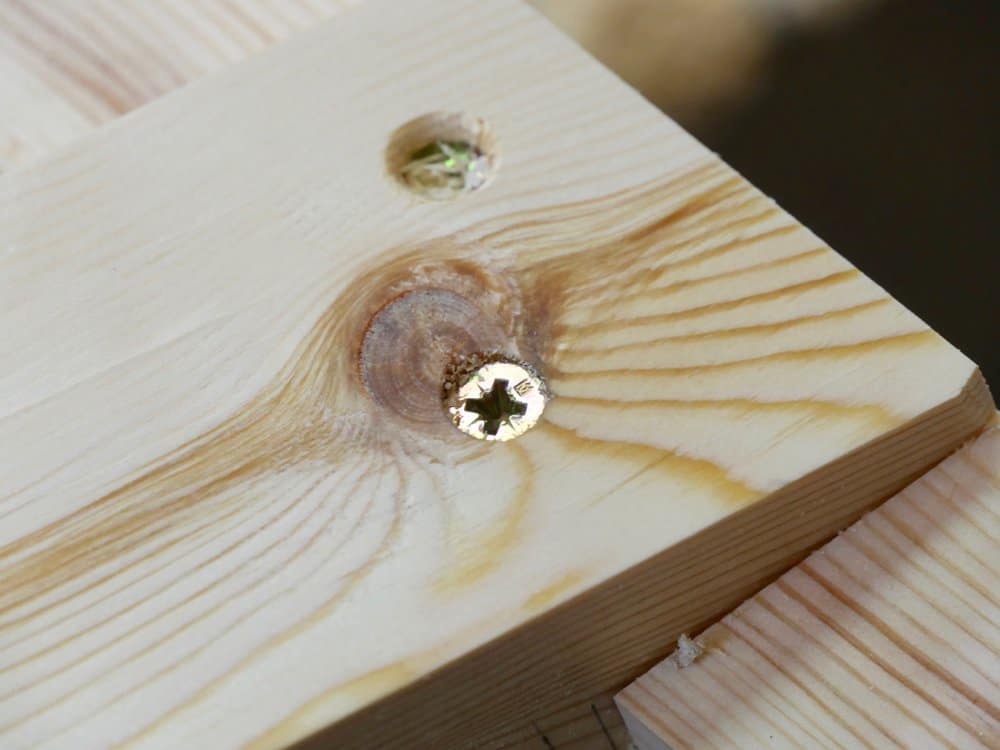The Bevel-down Planes Will Readily Repair Bevel-up tear-out


I planed a leg of my sawhorse with a bevel-up plane finely set and sharp. The plane throat was wide enough but not overly wide and my shoulder jarred as the grain grabbed the plane before yielding up its rootedness around the knot. It’s a strange enough thing that although grain tear-out is a common issue surrounding bevel-up planes, and of course it always has been, it seems to be an issue no one really wants to talk about. In my case it was more predictable because of the knot—some level of tear-out around knots is inevitable, but it also occurs frequently and predictably unpredictably on even straight grained wood. A very typical occurrence and usually quite predictable.

I immediately switched to a #4 Stanley and whipped off six successive shavings to bottom out the tear-out. Only a feint trace remains because I stopped. It’s still a sawhorse after all. Just an interesting point often missed by sales people and manufacturers.


Interesting post, I don’t own any bevel up planes and like you are very satisfied with my bevel down planes, especially the #4. There has been a lot of hype on the LA Jack Plane by Veritas on another forum and it looks to be a very nice looking plane. But I personally don’t think it is worth the money. I like Veritas tools and I have their small plow plane which is a great plane but I just can not get excited about the bevel up planes. Just my $.02 !
Steve
I do like them well enough, and savour them for some work, but when it comes to surface planing face grain, no matter the maker, they just don’t slice it with the guarantees you get from BD smoothers. I think they may work well on the easier woods like maple, curly maple, oak, walnut and such though; but still no better than a BD plane.
Thank you for your advices about choosing planes and how to work with them. Yesterday I bought a second-hand Stanley #4 1/2 in a flea market near I live. The man -an english man, by the way- who sold it me was been woodworker (now retired), was selling his tools and he had sold yet all the #4 Stanleys he had. I told him about your suggest in begin/work usually with a #4. “Paul Seller says we don’t really need a lot of planes”, I said, “just a #4 and, perhaps, a #5 if we need a bit longer plane, but no more”. He agreed. After almost an hour of conversation, after knowing about my interest in working with hand tools, he made me a special prize for a #4 1/2 and a #5 Stanley bailey planes, both of them in very good condition: 20 euro (about 17 pounds). “It’s cheap, I think”, I said. “Yes, but It’s nice for me that my tools go on being useful and working” -he said. Now these tools are at my house and I must look for a pair of rear handles for both of them, because they are rather worn, but the planes themselves are in very good condition. I will work with them… and, of course, I hope to go on learning from experienced woodworkers like you.
Thanks a lot again. I’m spanish, so I’m sorry if my english is not good enough.
J. Tellez, your English is just fine, even here in America! Sounds like you got a great deal on those planes — enjoy!!!
No probs with your English here. Totally understood your bargain accomplishments and glad he paid it forward. Well done.
Paul, with respect, there is something incorrect about the way you use a BU Jack plane for you to comment as you do.
The current crop of BU planes have a bed angle of 12 degrees. Most blades for these planes come with a 25 degree bevel. Used together, this creates a 37 degree cutting angle. This is only useful for end grain. If you plane face grain with such a set up, the wood will tearout. I suspect that is what you are experiencing.
Note that the #4 smoother has a 45 degree bed, which creates a cutting angle of 45 degrees. This has a significant advantage over the low angle set up above on face grain. However … if you give the BU blade a 33 degree bevel, it will also plane at a 45 degree cutting angle. This should produce the same result as the #4 you are using. Now give the BU blade a higher bevel angle – say 40 degrees – and it will outperform your #4 on more interlocked grain since it is planing with a cutting angle of 52 degrees. You can go up higher for increased performance.
The only way that a #4 will outperform a BU plane is if you bring the chipbreaker into action. But that is not what you do, so irrelevant in this example.
In all fairness I would say that you should mention the blade bevel angle/effective cutting angle of the plane. A B/U plane can be any number of angles. Yeah, sure a low angle will get tearout but at the same time do wonders on endgrain. Switch the blade for a higher angle, say on up to a 50 degree effective angle (12 degree bed + 38 degree blade), and now it will take figured wood shavings no problem.
I own the LV BU Jack, I know it’s not the same as a BD plane. I still turn to my BD high angled plane for highly figured woods and my standard BD for most all other work. I now typically use the LV BU for shooting and miters. Sure, I can do the same with my BD planes, but it’s easier and cleaner with a low angle iron in that BU plane.
The whole point really is this. Bevel up planes are not just an alternative to bevel down planes in my view and you do have to radically alter bevels to make bevel ups work when you do not need to do that to bevel downs. I don’t really like the idea being put around that these planes are just one and the same and its a matter of personal choice. When you start to regrind bevels to different angles because you have an inch or two of rough grain that can be taken care of by a regular bevel up in 99% of cases then it’s a significant ask in my view. Keeping a second iron with a back bevel on the large flat face to create a poor mans York pitch is fast and effective and cheap too. This too will take care of that grain as well as keeping a dedicated #4 bd plane with the poor man’s York pitch permanently too. That has always worked for me so it means most people can afford it. Regrinds in tough steels take much time and effort. Better off with a regular plane and avoiding the tearout in the first place and of course, as I said, no one will convince me that the bevel up planes are anything but predictably unpredictable when it comes to them planing flat faces. You don’t get too far through three or four boards before repair needs taking care of and a number 4 bevel down works every time for me. I do quite like the BU planes for some work though. I own several for the school and introduced them five years ago.
The important thing to me is that last little bit you mentioned, and why I have one. “I do quite like the BU planes for some work though.” That’s why I have mine, it’s not for everything and won’t replace my daily users, but it’s more of a specialty tools used on occasions when it excels.
Paul, it is important that you qualify your statements (because many here just accept what you say is gospel), and not reject a tool out of hand if you are not prepared to set it up as required. It leads to an incorrect conclusion.
As with you, I prefer to freehand sharpen, and this method does favour the BD plane. For this reason, I use Bailey pattern planes in the main. BU planes use higher bevel angles for the most part, and this is easier to prepare using a honing guide to create a secondary bevel. This is not practical to do by freehanding.
I have many years of testing planes for Lee Valley, and so am very experienced in the use of both BU and BD planes. There is absolutely no doubt in the minds of thousands of happy BU plane users – these planes work as promised. Indeed, because they are capable of higher cutting angles, they are preferred by many who are prepared to go to the trouble of honing a high secondary bevel. In reality, if one is a user of a honing guide, then it is no extra effort – just set the guide for whatever angle one prefers.
The point is, BU planes are very capable, but they are going to be poor performers on face grain if you are not prepared to create the required bevel angle. If this is what you do, then it needs to be stated. Otherwise you are not commenting from a level playing field.
Regards from Perth, Australia
Derek
Paul,
I do agree with Derek re: effective blade angle on a BU plane. My experience with BD planes has been even with the blade is very, very sharp, close mouth & cap iron and very shallow cut – I find myself hoping for best. Depending on results, I forgo the plane go to a scraper.
I’ve seen people skew a BD plane or even plane in a circular motion. Do you think this a good technique?
I like the BU on endgrain shooting and things like dressing dovetails. Also, the blade doesn’t dull as quickly.
I do think the one chap’s comment is incorrect in respect that a jointer plane should definitely be in the arsenal. You simply cannot joint a board with a #4.
But you can do just fine with a 5 and 5 1/2 perfectly well. That’s all I ever use. Works perfectly every time. Long planes are rarely true, and by that I mean unchangingly flat. I haven’t found them to be consistently flat so when people talk about edge jointing with them I feel questioning rise up in me. Mostly I flex them to the work because they do all bend a thou and that helps me get the flatness I want if indeed I must use a longer plane. Perhaps that’s just me. They do change according to temperature unless you enter the higher end of the market. I note that high end makers do not give flatness tolerances for their planes at the longer end and there is a reason for that I think. Oh, perhaps not everyone can joint with a number 4 and there is no need to struggle if you have a longer plane like a jack, but I can joint with my number 4 just fine too. Actually, what I was addressing has nothing much to do with the counter comments given here. It was simple enough. I picked up a bevel up plane with a combined angle of bed and bevel equalling 50 degrees and it tore out. It was sharp. Then I took a bevel down with a fixed bevel of 45 and it cleaned up perfectly. Quite simple really.
I had a BU plane. Key word is had. Well I still have one in my Lie Nielsen Scrub plane. If I have trouble with tear out I get it close and finish with a Cabinet Scraper. Works every time. A little tip I learned from Mr. Sellers himself.
Gary, a scrub plane is not offered in a BU configuration, and certainly not the LN. It is BD.
There is nothing wrong with using a scraper to remove tearout. This is an example of the effect of very high cutting angles, which is discussed above in the context of using a BU plane.
Regards from Perth
Derek
I heard a recent interview with Thomas Lie Nielsen, in this interview he commented that his Bevel up Jack Plane was one of his favorite products. I thought this odd since I had some disappointing results with mine until….I learned I was using it incorrectly. For me the great value is I can use it on the diagonal or cross grain to follow my Stanley Scrub plane to flatten a workbench . The variable mouth allows me to take thick shavings. I can use it on end grain as using a block plane. After roughing out the flattening process, I then to progress to my Stanley #5 my favorite or my Stanley #4.
Also, the Lie Nielsen BU iron can be exchanged for a toothing iron. I haven used it yet,
I had take classes from Brian Boggs in Asheville,NC a great maker of fine furniture and chairs.
Brian had a gorgeous table in his shop, the Lie NIelsen BU was his go to plane to flatten the top.
I subscribe to you premium classes.
The bevel up Veritas jack plane is my go to plane. I have multiple blades all ground to different angles so it is quick and easy to switch blades depending on what I am doing. It is a very versatile plane for all surfacing operations and even used as a shooting plane.
Many interesting options cropping up here. Glad for the input. In this case the issue was simple. The grain tore with a carefully managed BU jack plane used by a very experienced user and the quick and simple solution took care of the issue which was using the commonest of all planes, a #4 bevel down. Job sorted. Not multiple irons at £30 a pop but a secondhand £3.50 plane used since 1966. Common problem, simple solution and that’s all that was really said.
Why even use a BU if the BD is what you prefer? I don’t get why every so often there is a bashing on BU planes every couple of months on this blog. There are allot of people who love this planes. I don’t understand so much negativity directed at the tool. There are allot of people who have worked with BU planes and have allot of skill and knowledge to pass on. At the end of the day if the wood is so difficult to plane with out tear out break out your random orbital router and watch it disappear. Just make sure the purist don’t catch you.
Bevel up planes do have a place in today’s woodworking. They are very nice planes. The point here was and still is that I picked a plane, used it, and it tore out the grain. I picked up a bevel down plane and fixed. A random orbit sander has its place too, as you say, but using it in the place where I needed it would have taken away the sharpness I wanted to make it look like an American two by four. Si, now, is that more “negativity” rather than just plainly speaking the way it is? I prefer people to speak plainly and when people start bandying around this word I find it very negative.
So, should bevel up planes be used exclusively for end grain? I’m brand new to woodworking and found a Stanley 62 at an estate sale recently.
What are bevel up planes good for? I see people comment that they’re good for “specialty” uses or say “they have their use” but I don’t know what that is.
Not really. They work well for surfacing but not as well as bevel downs for most general joinery and furniture making. I like them especially for mitring and then squaring too, especially used with shooting boards to speed up the process. They are just non-essential planes unless of course this type of work is a speciality to your particular work. An instance might be if you specialised in certain picture frame making. Of course most such work in quantity would be instantly accomplished with a regular chopsaw and so that pretty much renders them obsolete for production work.
I have noticed that conversations about low angle bevel down planes are not as common. How do this work with end grain against a bevel up planes? Do they work as a regular bench plane also? I don’t have either of them. I was hoping to get a bevel up plane someday but maybe if I make a bevel down low angle plane right I can delay that feeling. I know I don’t need it… but as Mr. Sellers say, I don’t need a BMW either, jeje.
There is a difference but I can achieve everything well enough with a bevel down. Buying a bevel up is therefore a matter of personal preference for most rather than an essential. I do think that the lower angle of presentation makes the thrust more in line and direct and that is the difference. The point I am making really is that people should not feel they have to spend £200 plus to plane end grain. Most furniture makers of old did not own bevel up planes or if they did it was very much the rarity and yet they achieved ultra fine results with bevel down planes. Consider for instance moulding planes on end grain which could not be made as bevel up planes because of the profiling. The bevel-down planes cut cross grain just fine.